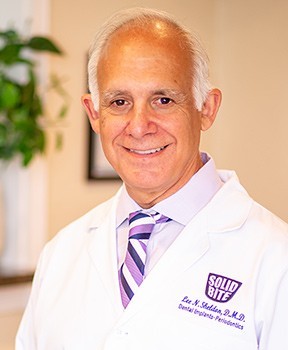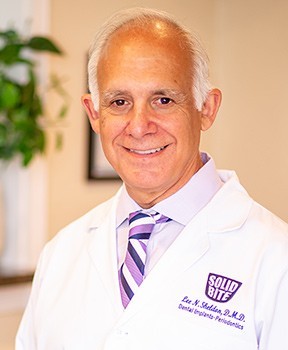In this new series, we’ll be asking questions and getting first-person perspectives on what it’s like so far to practice amid the pandemic. Every region, every practice, every practitioner has unique stories so we’re chronicling them here to give you an up-close and personal look at challenges, solutions and inspiring moments across the country.

Periodontist Dr. Lee Sheldon has been practicing for over three decades, so he has seen a lot of changes. An author and former associate clinical professor, he received his DMD from Tufts University School of Dental Medicine, and his certificate in Periodontistry from the University of Connecticut School of Dental Medicine. His practice, Solid Bite, is located in Melbourne, Florida. His recent article on creating brand awareness for specialists uncovered some startling survey results and offered a plan for countering lack of awareness—timely help as dentistry reopens under complex circumstances.
Q: When did you reopen your practice?
A: We found out on April 30th that we could reopen on May 4th, but we really didn’t reopen our practice on that date. During the previous few weeks, we started to look at PPE and how we could refigure our practice to make it satisfying to both our staff and patients. We bought some equipment and some PPE. By May 4th and May 5th, we were writing, drilling, and rehearsing our new protocols. I started by giving about a half-hour PowerPoint lecture as soon as we got there on May 4th to let the staff know what we’re doing to make it safe. On Monday and Tuesday, we did not see one patient; we just rehearsed and got comfortable with the protocols. On Wednesday, we saw about half the normal patient load, same on Thursday and Friday. Usually, when you’re putting in protocols in an office, you’re doing it one at a time. But here, we are putting in seven or eight new protocols all at once, so we had to go slowly to do that effectively. By the time we were done on Friday, everybody was really comfortable. On Monday, May 4th, we told patients we were open and the phone started ringing off the hook. From May 11th on, we’ve been going gangbusters—every single day, every single week with a ton of new patients. Even with a slow first week, we had a fabulous May.
Q: What has been the biggest challenge so far?
A: For us, the biggest challenge was deciding what equipment we needed in order to feel like we have everything we need to protect our patients and staff. We have a reception room that holds eight people, but to socially distance correctly, we can only have three people in the room at one time. So they wait in the car until we have the ability to allow three people in the reception room or until we’re ready for their appointment. There was a little bit of difficulty initially doing the histories and taking temperatures. It’s an additional step, but once you’re used to the step, that’s just the way it is.

Q: How have the changes in PPE affected your ability to practice?
A: In general, I think there’s a lot more sweating going on. Unfortunately, we couldn’t get any gowns that were light weight and we had to order food service gowns, which are much heavier. We’re able to get some lighter gowns now so we’re going to throw the heavier ones away and start over. It’s more difficult to breathe in face shields and people are sweating but not to the point where the staff is complaining. You look at it in two ways: mild discomfort versus safety. Even the CDC guidelines don’t say you have to change gowns between every patient, but we’re changing our gowns between every patient. The difficulty was mostly in the planning, but we took the necessary steps to make sure that was done correctly so we can practice the way we need to practice.
Q: How has the experience been with patients? Has it been difficult to encourage patients to come into the office?
A: Almost no difficulty. There were a few patients who told us they’re putting off their visits for a month or two. The steps we took allowed us to see our patients with the same frequency, even in hygiene. The hygienists told us they didn’t need any more time between patients than they were taking already.
Q: Have you encountered any challenges with staff members?
A: No, and I thought we would. Two staff members arrived for that initial lecture and were a little bit reluctant, but once they saw what we were doing and were comfortable, they had no reluctance at all. I think it made everybody feel better.
Q: Will dentistry ever return to what it was like pre-Covid? Should it? Or are the new precautions justified even in a world with a vaccine?
A: First of all, I don’t think we’re ever going to have a vaccine. We’ve never been successful with a flu vaccine; this will not be any different. We already have a feeling that the virus is going to survive. The virus wants to survive, it’s not killing off as many people as it was before. If the virus is changing, I can’t imagine we’re going to have vaccines that kill every mutation. Do I think it was appropriate to take the mitigation steps? I think it was long overdue. The last time we changed our protocols in dentistry was in 1986 after AIDS. To wait 34 years to change protocols was too long. Unfortunately, there is no standard protocol. We’re doing things that other people aren’t doing and other people are doing things that we’re not doing. We don’t know what is ultimately going to be correct, but increasing the discipline to decrease the possibility of infection and viral contamination is a good thing. Does it cost a little bit more money? Yes. Are we charging our patients $12 for procedures that use aerosols? Yes. We have gotten no squawking from patients when I tell them it’s an additional $12 fee for the particular visit. I think whenever you can put in some disciplines, it makes it safer for the staff. It makes it safer for the patient. I think it was a good thing. I wish we didn’t have this excuse to do it but I’m happy we did.


